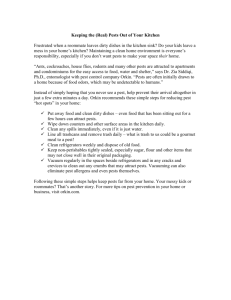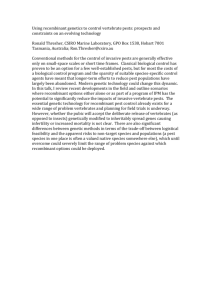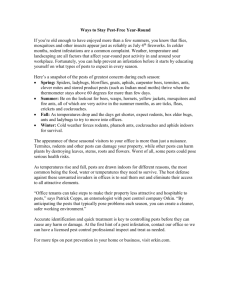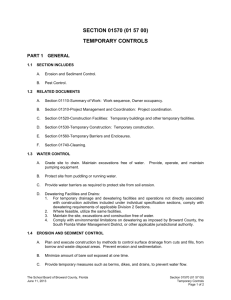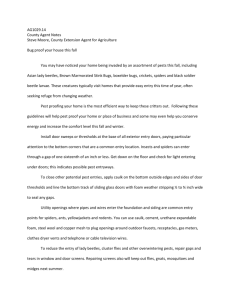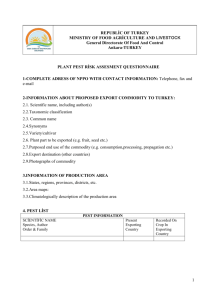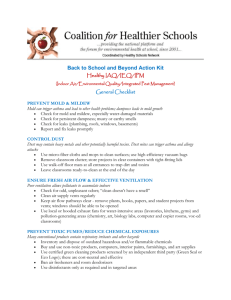Pest Control: Good Operating Practice Guidance
advertisement
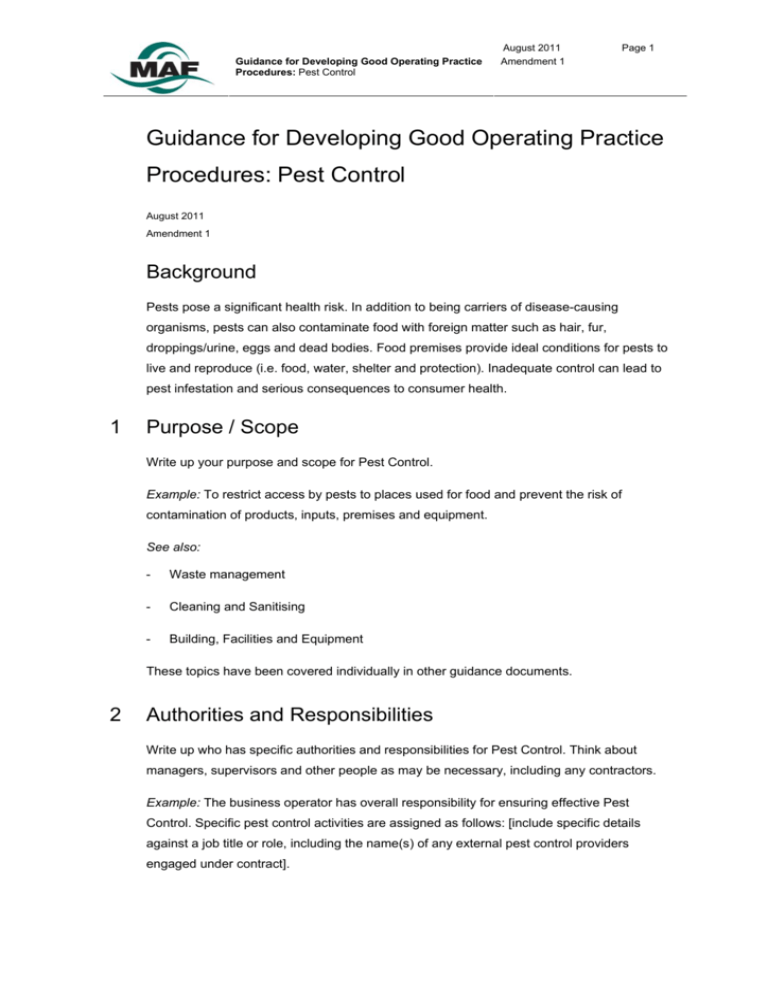
Guidance for Developing Good Operating Practice Procedures: Pest Control August 2011 Amendment 1 Page 1 Guidance for Developing Good Operating Practice Procedures: Pest Control August 2011 Amendment 1 Background Pests pose a significant health risk. In addition to being carriers of disease-causing organisms, pests can also contaminate food with foreign matter such as hair, fur, droppings/urine, eggs and dead bodies. Food premises provide ideal conditions for pests to live and reproduce (i.e. food, water, shelter and protection). Inadequate control can lead to pest infestation and serious consequences to consumer health. 1 Purpose / Scope Write up your purpose and scope for Pest Control. Example: To restrict access by pests to places used for food and prevent the risk of contamination of products, inputs, premises and equipment. See also: - Waste management - Cleaning and Sanitising - Building, Facilities and Equipment These topics have been covered individually in other guidance documents. 2 Authorities and Responsibilities Write up who has specific authorities and responsibilities for Pest Control. Think about managers, supervisors and other people as may be necessary, including any contractors. Example: The business operator has overall responsibility for ensuring effective Pest Control. Specific pest control activities are assigned as follows: [include specific details against a job title or role, including the name(s) of any external pest control providers engaged under contract]. Guidance for Developing Good Operating Practice Procedures: Pest Control 3 August 2011 Amendment 1 Page 2 Control Measures Write up how you ensure pests are controlled. Consider at least the following points: how you prevent ingress of pests, e.g.: - proofing the premises against pests (e.g. by putting covers on drains, screens on windows, seals on doors and repairing holes in walls, etc. For more information refer to separate guidance for Buildings, Facilities and Equipment); - checking/monitoring incoming foods and equipment for signs of pests; - training staff to recognise and report signs of pest infestation, building damage and possible entry points; - ensuring the regular removal of food and other waste and effective cleaning of waste areas to reduce food sources for pests and prevent conditions for them to breed and survive; - ensuring water is not allow to pool and any spills are mopped up immediately; - checking/monitoring for signs of pests in the premises and taking immediate corrective action to bring the situation under control (refer to control measures in the bullet below); - implementing other hygienic practices to protect against pests (e.g. closing delivery doors after receiving/despatching goods.). how you ensure there are effective control measures in place to deal with occasional pests and prevent infestation, e.g.: - where appropriate, ensuring physical control measures (e.g. bait stations, electric insect killers, curtains and traps) are provided and are used and maintained in accordance with the manufacturer’s instructions; or - ensuring any chemical control measures (e.g. applying pesticides, insecticides, fumigants) are carried out by a suitably qualified person (certification may be required). how you ensure pest control measures do not cause food contamination, e.g.: - ensuring the appropriate location and placement/positioning of control measures (e.g. electric fly killers, rodent baits, automatic insecticide dispensers) to avoid possible product contamination; Guidance for Developing Good Operating Practice Procedures: Pest Control - August 2011 Amendment 1 Page 3 storing pest control products under lock and key where they can’t contaminate food and food areas - see also Chemical Control; - ensuring the appropriate collection and disposal of dead pests; - carrying out the control of pests in ways that do not give rise to food contamination , e.g. by removing food and food-contact packaging from areas before treatment is carried out; by covering food equipment; by treating pests outside normal operating hours to minimise disruption to normal food activities, and - ensuring the area is adequately ventilated, cleaned and sanitised before recommencing operations. 4 Monitoring Write up how you check that you’re keeping pests out, and how staff or others (e.g. contractors) are working to ensure that there are appropriate pest control measures in place. Consider the following checks: regular visual inspections (e.g. there are no gaps in the building fabric that allow pests in; drain covers are in place; food waste is kept in sealed containers; food and other rubbish is removed regularly; food spillages are quickly cleaned-up, water isn’t allowed to pool, etc.); looking for signs of pest activity (e.g. bait taken, gnawing damage of food containers, rodent/bird faeces, stored product pests – moths, weevils) checking that pest control equipment is operating correctly; and reviewing records - are contractors checking for the right pests, are they meeting their contract obligations, are there any pest trends (e.g. seasonal, related to suppliers) are there on-going problems (e.g. lack of staff awareness). 5 Corrective Action Write up how you correct any problems that monitoring identifies, or that you otherwise become aware of. Include how you cover the following: 1. Defining the extent of the problem (i.e. what has happened, why and when it happened, how it happened and whether any product has been affected); 2. Restoring control (i.e. the action needed immediately to stop more product becoming affected and to fix problem); Guidance for Developing Good Operating Practice Procedures: Pest Control August 2011 Amendment 1 Page 4 3. Dealing with affected product and equipment. (e.g. preventing any unsafe product from being used - see the separate guidance for Complaints, Non-conforming Product, Corrective Action and Recall); and 4. Preventing re-occurrence (e.g. using information gained from the problem to identify better ways to do things; developing better procedures; improve checking systems; provide better staff training etc.). 6 Documentation and Record Keeping Determine what records you need to keep for this procedure. These will help you to introduce and maintain consistent good practices, and to demonstrate to your verifier (auditor) that you are sufficiently controlling those factors that can impact on the safety and suitability of the food. Assess any records you already have, and introduce any additional records you need for the monitoring and corrective action activities you specify in your procedure. When monitoring, you may have an option to either: - record every check; or - indicate that checks have regularly been carried out (e.g. throughout a week) and only record the results of a specific check where something went wrong. In these instances, always make a record of what you did to put things right (the corrective action). Keep blank record forms handy for staff to use and let people know where they are. Keep completed record forms together where they can be found easily for your regular internal verification checks. For your general programme requirements refer to the guidance document on the appropriate risk-based programme or plan which can be found on the Food Safety website.


